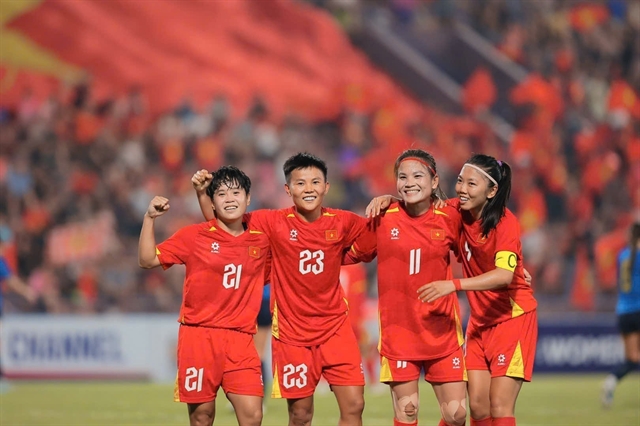Ambition is healthy, but only if it rides on a plan that reaches all the way down to muddy school pitches and cash-strapped clubs.

Players of the Việt Nam national women's football team celebrating their goal against Guam in the 2026 AFC Women's Asian Cup qualifiers. The team has a goal to reach the next two FIFA Women's World Cups. VNA/VNS Photo Phạm Tuấn Anh
Anh Đức
Every few years, Vietnamese football unveils a new headline dream. The latest sounds bolder than ever: the men’s team in the 2034 World Cup, the U23s at the 2028 or 2032 Olympics, and the women’s side in two consecutive Women’s World Cups.
Ambition is healthy, but only if it rides on a plan that reaches all the way down to muddy school pitches and cash-strapped clubs.
Right now, that linkage is thin. Ask any youth coach and you will hear the same gripe: we have a four-tier pyramid, but almost nothing beneath it. Thousands play seven-a-side because eleven-a-side pitches are scarce and costly, yet that improvised game gets more attention than some V.League fixtures.
One or two shiny academies, Viettel, PVF, Hoàng Anh Gia Lai, show what is possible, but they are islands in a sea of under-coached districts. A nation that wants to sit among Asia’s top ten cannot rely on isolated oases.
Short-term glory remains the default metric. SEA Games gold or an AFF title buys headlines, funding and political goodwill, so national-team coaches demand extended camps to chase medals. Those camps paper over a deeper truth: the V.League still does not harden players enough. Every time we stretch the calendar to nurse the senior squad, youth programmes go hungry, and clubs postpone the upgrades that would make such camps unnecessary.
Money is the other elephant in the room. Two and a half decades into 'professional' football, many clubs depend on a single patron’s chequebook. When that patron loses interest, budgets evaporate overnight. You cannot build a World Cup pipeline on sponsorship deals that wobble every season. The league needs tougher licensing, academies, audited budgets, community outreach, or no participation. At the same time, the league operator must help clubs broaden revenue streams so a bad season on the pitch is no longer a financial cliff.
How then can we turn the 2034 slogan from a dream into reality?
One: Put youth first. Reward clubs that meet clear academy benchmarks - AFC-licensed coaches, transparent spending and tangible minutes for home-grown players. Penalise those who tick boxes on paper but produce no talent. A competitive league full of well-run academies will develop future internationals far better than month-long national-team boot camps.
Two: Fix the calendar. Use FIFA windows for proper friendlies against stronger nations, even if defeat stings. Keep regional tournaments for youth or second-string squads. Losing now, while learning, costs less than crashing in the final phase of World Cup qualification.
Three: Modernise finance. Encourage multi-sponsor or community-share models that spread risk. Gate receipts will remain modest until stadiums improve, but creative merchandising, streaming, and local partnerships can cushion budgets. Clubs that stand on more than one leg let coaches plan in years, not months.
Finally, be transparent. Fans have heard 'World Cup project' before. Publish annual scorecards: new grassroots pitches laid, youth licences issued, minutes played by U23s and financial health of each club. Celebrate progress; own the setbacks.
Japan did this in the 1990s, ticking off realistic milestones rather than rewriting the dream every cycle.
Ambitious horizons are not the problem - ships without charts are. If the 2034 target appears at the end of a detailed plan rather than the start of a press conference, supporters will rally behind it. Otherwise, we risk another decade of grand announcements followed by the same rueful sigh: “Maybe next time.” VNS